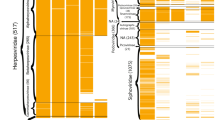Summary
The DNA of macropodid herpesvirus 2 (dorcopsis wallaby herpesvirus) was analysed using restriction enzymes and molecular cloning techniques. Sets of EcoRI and SalI clones were prepared which represented approximately 85 per cent of the genome, and these clones were used to map the DNA by double-digestion and hybridization experiments. Data on uncloned regions were obtained by analysing fragments excised from agarose gels, and terminal fragments were identified by exonuclease III digestion. The genome was shown to be approximately 135 kilobases (kb) long. It has a long unique sequence (95 kb) bounded by repeat sequences (5.5 kb) and joined at one end to a short unique sequence (15 kb) also bounded by repeat sequences (7.0 kb) in a manner similar to that of herpes simplex viruses 1 and 2.
Similar content being viewed by others
References
Bolivar F, Rodriguez RL, Greene PJ, Betlach MC, Heytener HL, Boyer HW, Crosa JA, Falkow S (1977) Construction and characterisation of new cloning vehicles. II. A Multipurpose cloning system. Gene 2: 95–113
Cortini R, Wilkie NM (1978) Physical maps for HSV type 2 DNA with five restriction endonucleases. J Gen Virol 39: 259–280
Denhardt D (1966) A membrane filter technique for the detection of complementary DNA. Biochem Biophys Res Commun 23: 641–652
Dickson J, Hopkinson WI, Coackley W, Spence T, Fairfax R (1980) Herpesvirus hepatitis in rat kangaroos. Aust Vet J 56: 436–464
Finnie EP, Littlejohns IR, Ackland HM (1976) Mortalities in parma wallabies(Macropus parma) associated with probable herpesvirus. Aust Vet J 52: 294
Hayward GS, Jacob RJ, Wadsworth SC, Roizman B (1981) Anatomy of HSV DNA: Evidence for four populations of molecules that differ in the relative orientations of their long and short components. Proc Natl Acad Sci USA 72: 4243
Holmes DS, Quigley M (1975) A rapid boiling method for the preparation of bacterial plasmids. Anal Biochem 114: 193–197
Honess RW (1984) Herpes simplex and “The Herpes Complex”: diverse observations and a unifying hypothesis. J Gen Virol 65: 2077–2107
Johnson MA, Whalley JM, Littlejohns IR, Dickson J, Smith VW, Wilks CR, Reisner AH (1985) Macropodid herpesviruses 1 and 2: two herpesviruses from Australian marsupials differentiated by restriction endonucleases, DNA composition and hybridization. Arch Virol 85: 313–319
Kerr A, Whalley JM, Poole WE (1981) Herpesvirus neutralizing antibody in grey kangaroos. Aust Vet J 52: 347–348
Nilsson B, Ulhen M, Josephson S, Gatenbeck S, Philipson L (1983) An improved positive selection plasmid vector constructed by oligonucleotide mediated mutagenesis. Nucleic Acids Res 11: 8019–8030
Nonoyama M (1982) The molecular biology of Marek's disease herpesvirus. In: Roizman B (ed) The herpesviruses, vol 1. Academic Press, New York
Rigby PJ, Dieckmann M, Rhodes G, Berg P (1977) Labeling deoxyribonucleic acid to high specific activity in vitro by nick translation with DNA polymerase 1. J Mol Biol 113: 237–251
Roizman B, Carmichael LE, Deinhardt F, De-The G, Nahmias AJ, Plowright W, Rapp F, Sheldrick P, Takahasi M, Wolf K (1981) Herpesviridae. Definition, provisional nomenclature and taxonomy. Intervirology 16, 201–217
Sheldrick P, Berthelot N (1974) Inverted repetitions in the chromosome of herpes simplex virus. Cold Spring Harbor Symp Quant Biol 39: 667–678
Skare J, Summers WC (1977) Structure and function of herpesvirus genomes II. EcoRI, XbaI and HindIII endonuclease cleavage sites on herpes simplex virus type 1 DNA. Virology 76: 581–595
Southern EM (1975) Detection of specific sequences among DNA fragments separated by gel electrophoresis. J Mol Biol 98: 503–511
Stinski MF (1983) The molecular biology of the cytomegaloviruses. In: Roizman B (ed) The herpesviruses, vol 2. Plenum Press, New York, pp 67–113
Thuring RWJ, Sanders JPM, Borst P (1975) A freeze-squeeze method for recovering long DNA from agarose gels. Anal Biochem 66: 213–220
Tyndale-Biscoe H (1973) Relationships and origins. In: Tyndale-Biscoe H (ed) Life of marsupials. E Arnold, London, pp 1–36
Wadsworth S, Jacob RJ, Roizman B (1975) Anatomy of herpes simplex virus DNA. II. Size, composition, and arrangement of inverted terminal repetitions. J Virol 15: 1487–1497
Wahl GM, Stern M, Stark GR (1979) Efficient transfer of large fragments from agarose to diazobenzyloxymethy-paper and rapid hybridization using dextran sulphate. Proc Natl Acad Sci USA 76: 3683–3687
Webber CE, Whalley JM (1978) Widespread occurrence in Australian marsupials of neutralizing antibodies to a herpesvirus from a parma wallaby. Aust J Exp Biol Med Sci 56: 351–357
Whalley JM, Webber CE (1979) Characteristics of parma wallaby herpesvirus grown in marsupial cells. J Gen Virol 45: 423–430
Wilkie NM (1973) The synthesis and substructure of herpesvirus DNA: the distribution of alkali-labile single-strand interruptions in HSV-1 DNA. J Gen Virol 21: 453–467
Wilkie NM, Cortini R (1976) Sequence arrangement in herpes simplex virus type 1 DNA: identification of the terminal fragments in restriction endonuclease digests and evidence for inversions in redundant and unique sequences. J Virol 20: 211–221
Wilks CR, Kefford B, Callinan RB (1981) Herpesvirus as a cause of fatal disease in Australian wallabies. J Comp Pathol 91: 461–466
Author information
Authors and Affiliations
Rights and permissions
About this article
Cite this article
Johnson, M.A., Whalley, J.M. Restriction enzyme maps of the macropodid herpesvirus 2 genome. Archives of Virology 96, 153–168 (1987). https://doi.org/10.1007/BF01320957
Received:
Accepted:
Issue Date:
DOI: https://doi.org/10.1007/BF01320957




